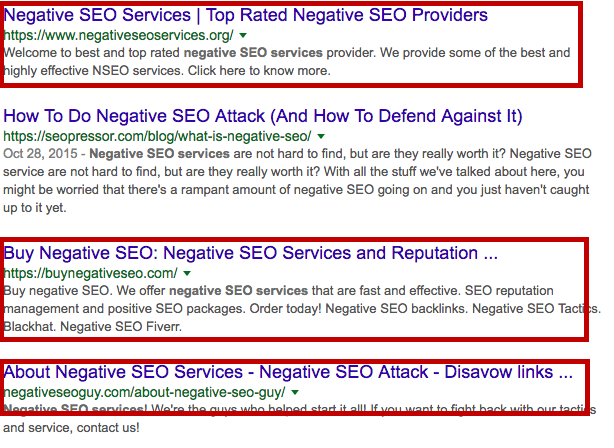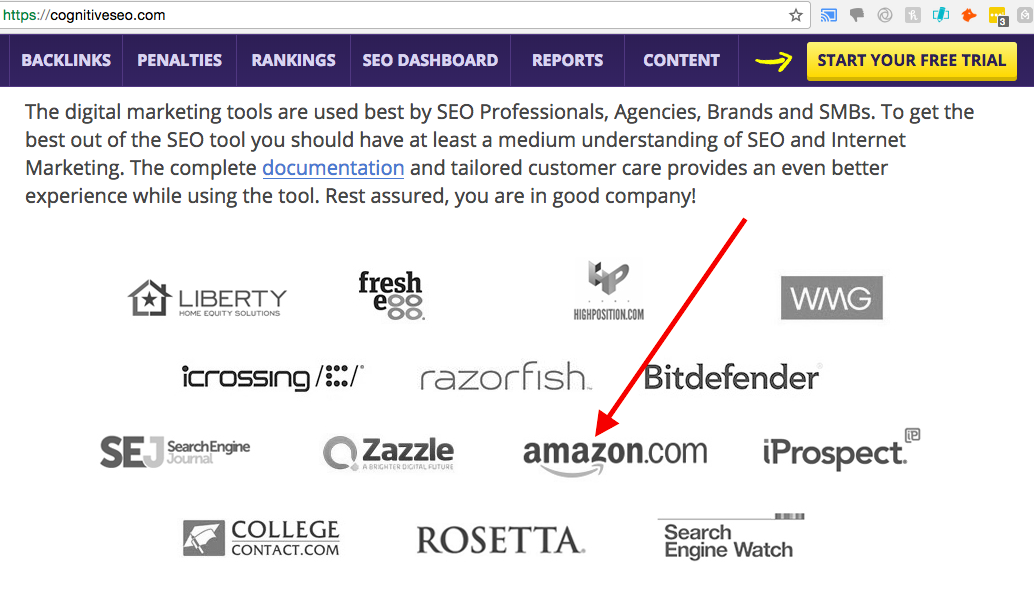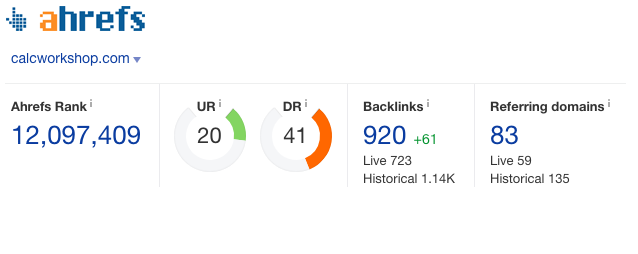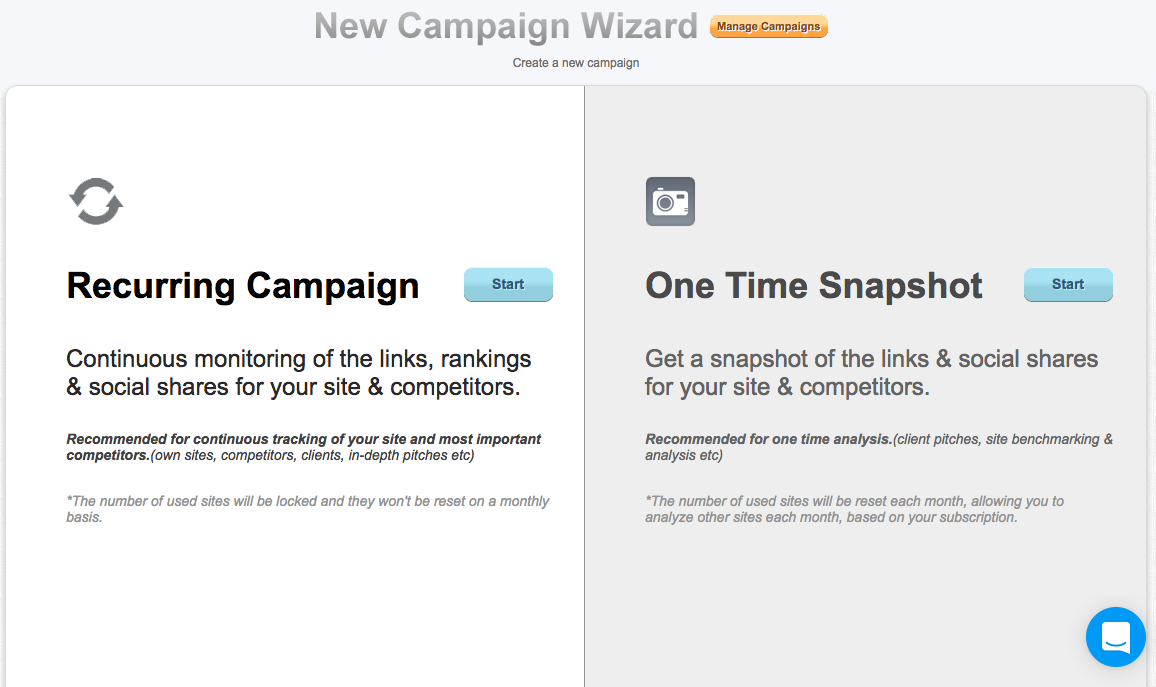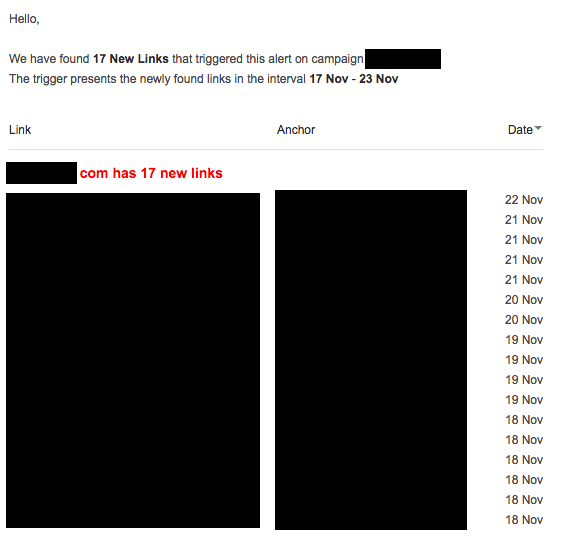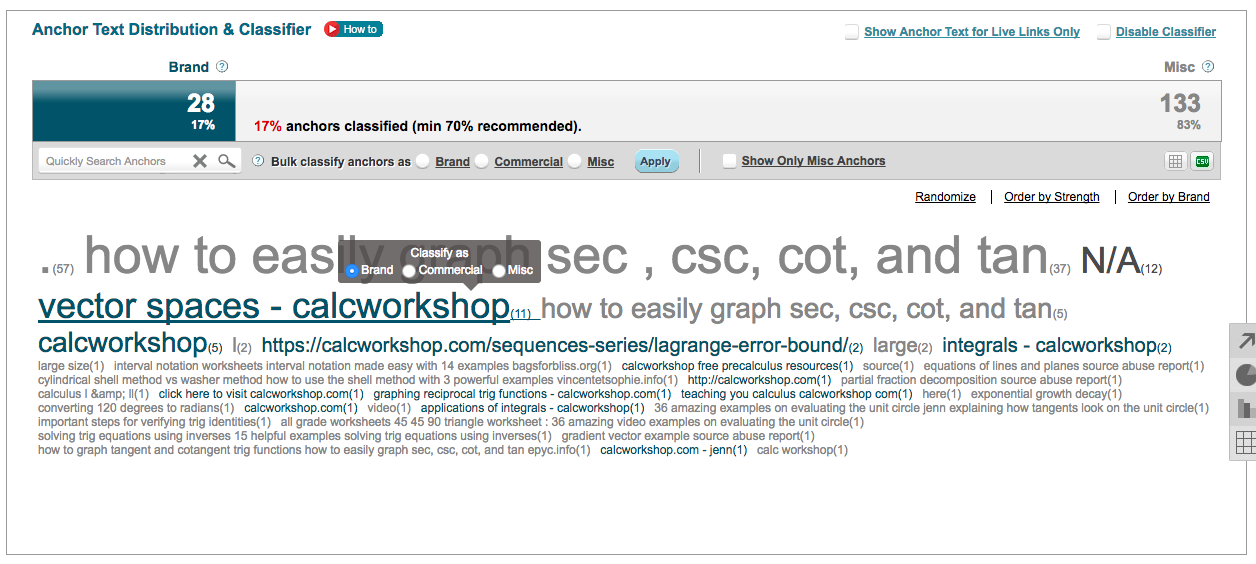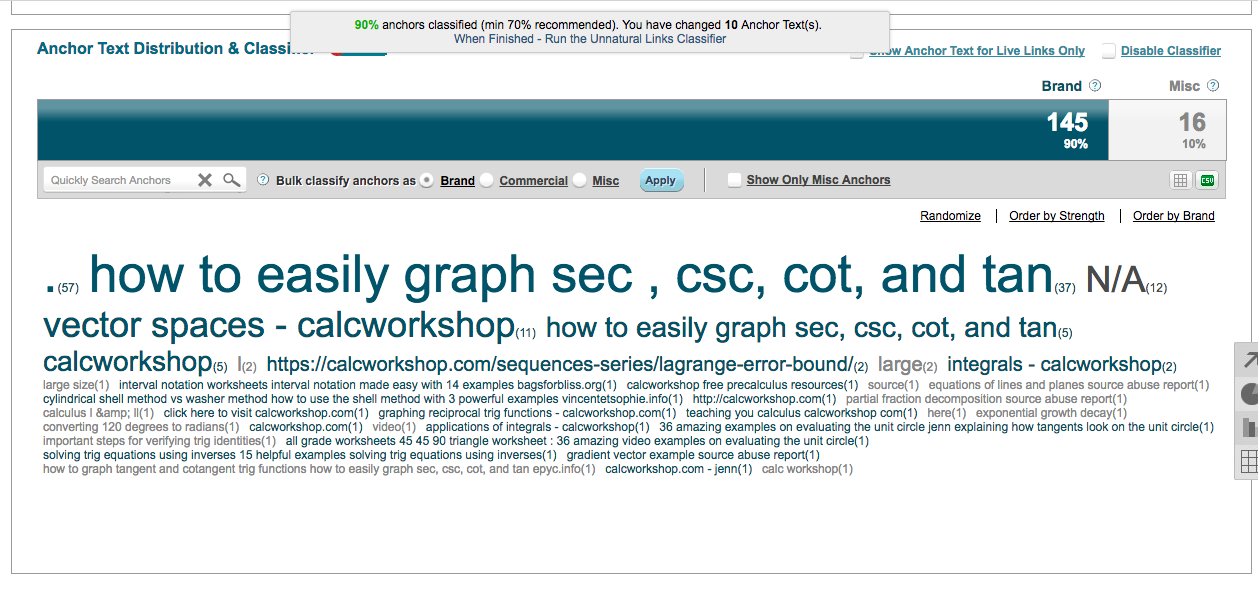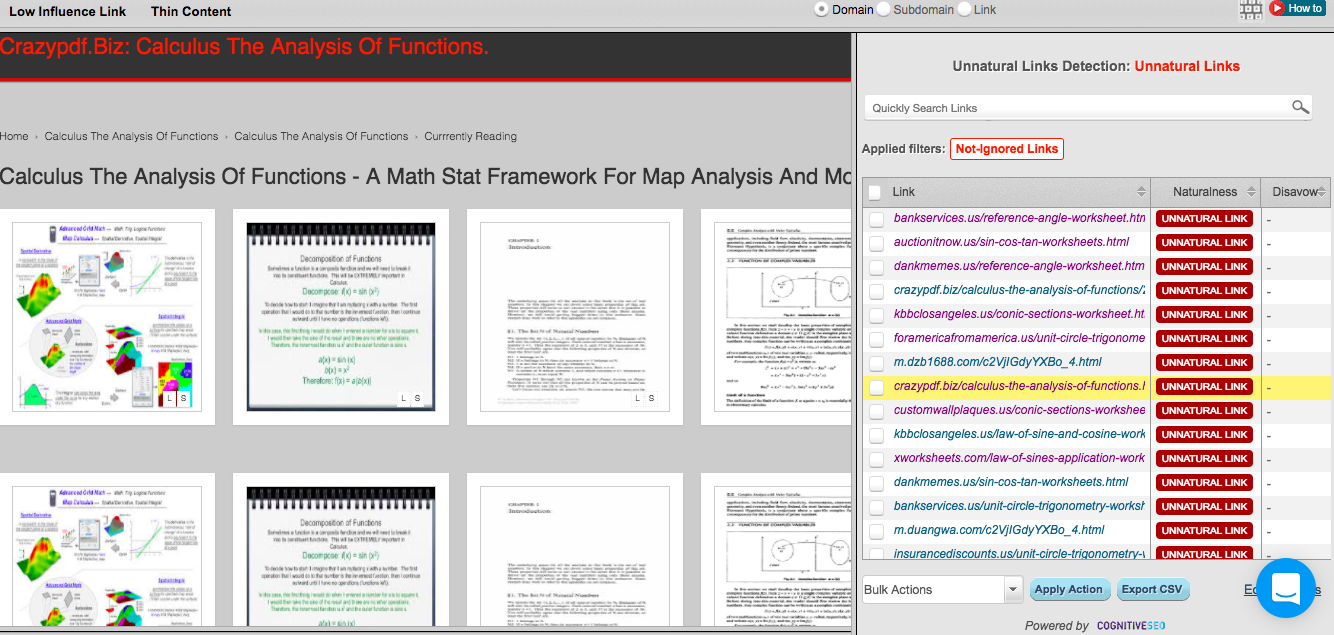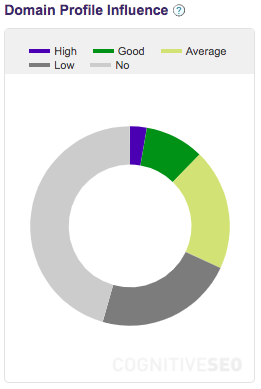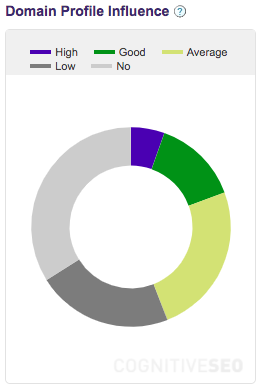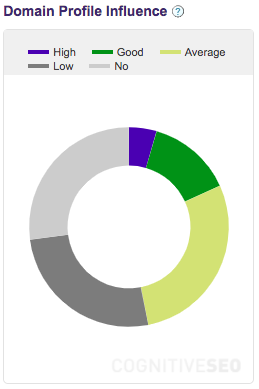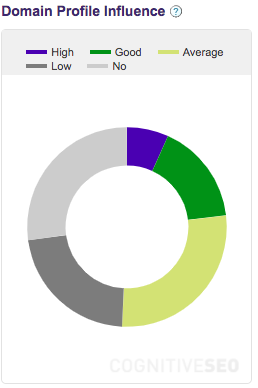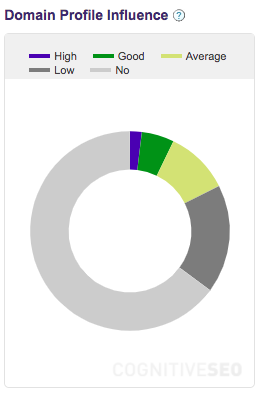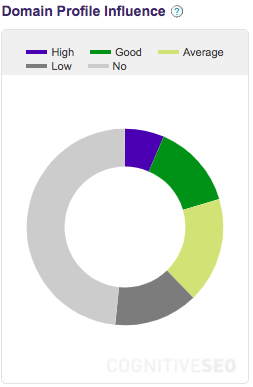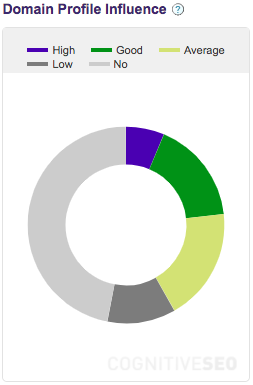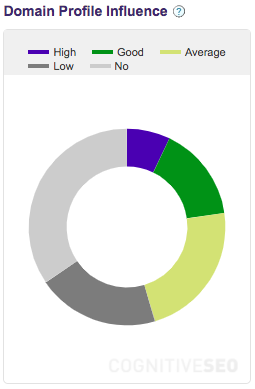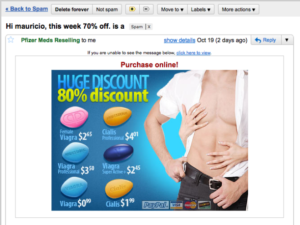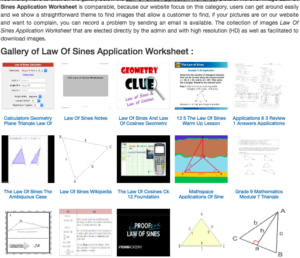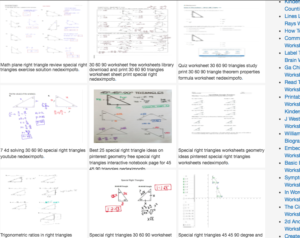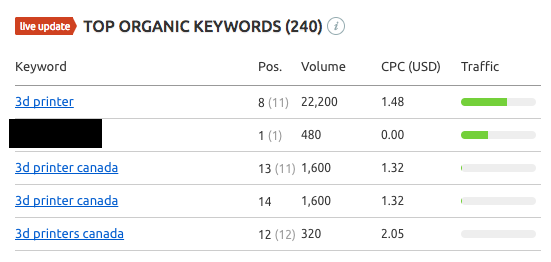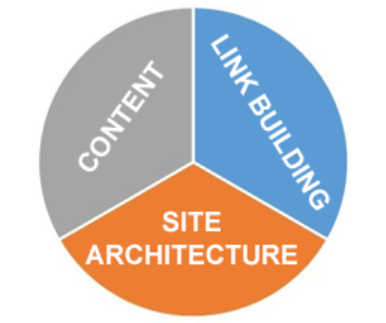Even in this day and age, where using the internet just a regular thing for most, it’s amazing how almost every potential client I meet not utilizing this tool.
I’m talking about funded established organizations that are totally oblivious on how they are missing out on at least 30 percent in revenue.
No I’m not talking about NoseBook (Facebook), InstaSpying (Instagram) or any other social media tool that people waste their time on.
I’m talking about the classic and ever so lovely autoresponder. Originally used to send just reminders through email, the auto responder has now developed into a full on email marketing automation powerhouse.
If you are not using some variation of an autoresponder on your web presence, you are missing out on some decent and consistent sales / traffic.
It’s the easiest get a minimum 30 percent increase in your conversions right now (From your existing traffic) and your own in-house tech team can implement it in a few days.
Let’s look at some numbers . . .
- According to the National Client Email Report, the ROI on every email sent that would cost $1 $38. Now that’s a ROI.
- WBresearch concluded that 80 percent of marketers prefer email marketing to acquire customers. It makes sense because everyone has an email. After all, you need an email address to join any of these annoying social networks that are out there today. Also email a , tried and tested technology. Most people trust it.
- Conversion rate of email marketing much higher than social media. Smart Insights just conducted a study in December 2017 and found out the overall conversions from email are much higher than any other social media channels.
- Here the best part, 76 percent of customers like hearing from you through email.
I can go on and on with the stats but I think you get the idea.
Heck I’ve personally used this system or variations of it for the past 10 years and it kills it every time.
Month after month.
I’m using it on this site as well. It just works.
Also I’m not a social media hater but I don’t waste time on the next ‘big’ thing.
Stick to what works and you’ll get the results you seek.
Anyways, a robust autoresponder / newsletter system will help you build relationships with potential customers, will keep your website rising in the search engines (Due to consistent direct traffic that spreads to other pages) and finally, increase conversions due to massive trust that was built by a properly laid out system.
If you are not using an autoresponder / newsletter system, you are leaving money on the table.
It’s as simple as that.
So moving forward, it with great pleasure that I would like to share my personal “secret sauce” on how to implement an autoresponder / newsletter system on your website.
My goal to help you see the true power of this awesome system.
Once placed, it literally runs by itself and will continue to generate massive amounts of business year after year.
If you are just starting out with a website, this could be really phenomenal stuff for your growth.
However, if you currently have 10 rankings and some great products to go along with it, implementing a newsletter / autoresponder system will only help you convert a whole lot more.
Now before we dive in further, let’s first look at how this whole ‘art of selling’ works.
Once you understand this basic concept, than you’ll have way more fun with it. By fun I mean more sales.
Whether it’s in the ‘physical’ world or ”, the way you sell something the same anywhere.
Let’s have a look at how this process works in the “Physical” world first.
Generally speaking, there are 3 types of people who will visit your brick and mortar store:
- Visitor Type 1 (V1) : The Window Shopper.
- Visitor Type 2 (V2): The “On The Fence” Visitor.
- Visitor Type 3 (V3): The Buyer.
| Window Shopper | "On The Fence" Person | The Buyer | |
|---|---|---|---|
| Physical World | This person is just hanging out. They have no interest in what you are selling and they are not looking to buy anything either. Just walking around, killing time . . . | This person is interested in your product but is just not ready to make a purchase. They are the kind who will ask you for more info (Perhaps a brochure), take it, will make some small talk (Oh the weather eh . . . ) and then move on. | This person knows what they want and that's why they are in your store. They will pay you, get the product and leave. |
| Online World | They are just 'browsing' as it's called online. At most, they might be doing some research on the subject but that's pretty much it. | They like what your website has to offer. However, something is holding them back. They just can't seem to 'trust' you enough to whip out their credit card and proceed with the sale. | They know what you are selling and that is why they came to your website. They punch in their credit card info and they are done. |
So what does this tell you?
Whose contact information should you get?, follow up with?, offer value and close the sale?
The answer Visitor Type 2.
Why should you even bother to contact Visitor Type 2?
The “Visitor Type 2” will be between 30 percent to 90 percent of your business (Depending on your ).
When you don’t contact them, you are losing up to 90 percent of your business.
With a minimum loss of at least 30 percent.
Either way you look at it, that’s a lot of business.
As I mentioned earlier, the “Visitor Type 2” people are interested in your offer but either need more information or at some point, you simply need to remind them.
That’s it.
How do you build trust and establish a relationship with the ‘Visitor Type 2’?
It’s very simple.
By giving away free valuable information.
Let’s jump back to the physical world for a second . . .
When you give a brochure or free information in the ‘physical’ world, it does a lot of things . . .
- It shows the visitor that you know your stuff (Makes you look like an expert).
- It shows the visitor that you would rather educate them (Or help them) in their buying decision instead of blatantly sell to them. Basically, what you are doing at this point giving real value.
- It shows the visitor that you are more than willing to build somewhat of a relationship with them. Which shows your lead that you are genuine and this establishes the thing that matters the most . . . trust).
You are showing your visitor (Who you are a complete stranger to, never forget that), that you know your stuff.
In addition, you are also educating your visitor so they make the best buying decision. Long story short, you are helping them decide if your or service genuinely right for them or not.
This naturally establishes trust within and they feel comfortable dealing with you.
Plus when you give free information through your website, you are using a tried and tested sales process that has been around since the first sale was ever made in history.
Which was when Eric “The Caveman” Cornelius exchanged his two sticks for Jason “The Bison Killer” McGee’s rock.
Okay . . . I made this last part up but you get the point.
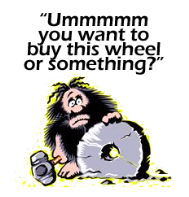
Next step to give them information regularly. In fact this an essential step. As most “Visitor Type 2” buyers, won’t make a buying decision on the spot. So in exchange for a brochure, you get “Visitor Type 2″s basic contact information.
These guys are interested in what you have to offer so the majority of them won’t say no.
This simple process gives them the information they need and gives you a follow up with them as well.
Eventually you will call them, talk for a few and than close the sale.
So just to recap:
| Selling In The Physical World |
|---|
| Visitor Type 2 walks into your store. |
| You give them a brochure in exchange for their contact info. |
| You follow up with them (Call them, Email them, etc). |
| Soon the sale is closed. |
Either by you presenting a call to action or by the “Visitor Type 2” themselves.
This how a sale made in the ‘physical’ world.
How do you mimic this entire sales process ?

When someone lands on your website, how can you say “Sir or Madam, if you like some more information regarding our products or services, I can call you later this week . . ”
Now to apply this customer relationship building process , you need a special ‘tool’ and this where a email marketing and an autoresponder system comes in.
| Selling In The Physical World | Selling In The "Online" World |
|---|---|
| Visitor Type 2 walks into your store. | Visitor Type 2 lands on your website. |
| You give them a brochure in exchange for their contact info. | You offer them an 'eBook, Brochure, PDF, etc' for their email. |
| You follow up with them (Call them, Email them, etc). | An automated email sequence follows up with them with a link to your site. |
| Sale is closed. | Sale is closed. |
- Visitor Type 2 lands on your site.
- Sees an offer attached to an email form.
- Signs Up.
- Starts Getting Your Emails.
- Eventually Takes Action. Sale or unsubscribed.
As you can see, it’s literally the exact same process.
That’s it.
However, an incredible advantage you have with this system your ‘sales person’ replaced by an automated system.
A 100 percent, hands free automated sales system, that runs like a well oiled machine day in and day out, 24 / 7.
Can you see the power of this system and why all the big boys (Amazon, Wayfair, etc) use it?
Now let me show you how to implement it properly.
We’ll do this in the two simple steps first:
- The Initial Email Offer:
What can you give the visitor so they will be happy to give you their email address? - The Email Sequence:
What will you put in your emails?
The Initial Offer:
Here the idea to get your customer to give your their contact information ,
Now this where you might have to do some testing as it all depends on your niche. You really have to do some digging around to see what works but in my case, people come to me because I can get them more customers.
How do I do that?
By ranking their websites for their targeted keywords.
So my offer on the site case studies of how I’ve ranked sites in the past.
This entices my visitor who naturally looking for customers on how I do it and than go from there.
So what you need to do ask your self the following questions:
- What does my customer want from me?
- How would my or service benefit them?
Than give them the appropriate information in the shape of a PDF, Video series, just email newsletters, etc
Here are some examples:
TigerDirect uses “Email Deal Alerts”. They get users to sign up by offering them special deals. A pretty common way of getting the “Visitor Type 2” email address.
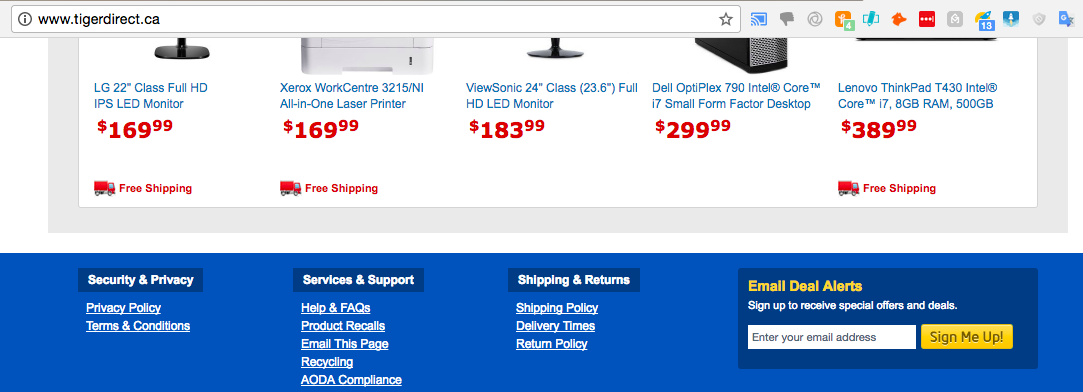
Wayfair.ca uses something similar as well.
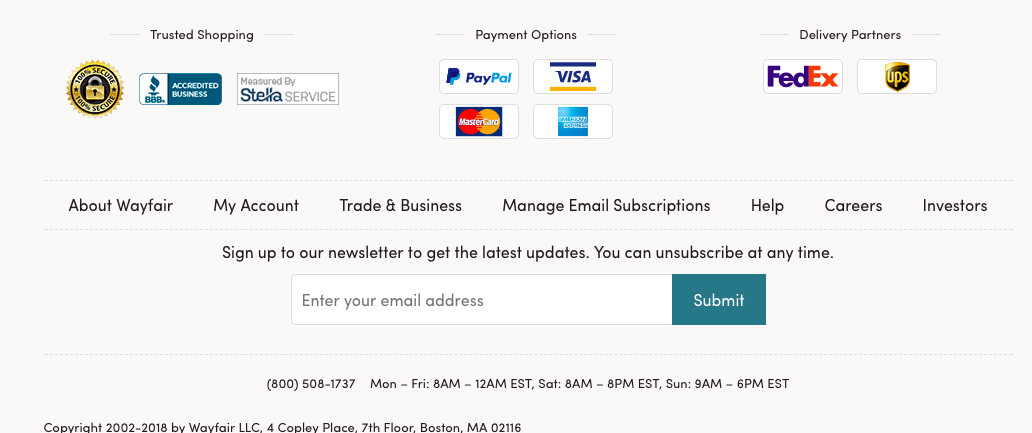
Fab.com uses straight up hover ad (They convert very well by the way) and offers a 10 percent off discount to each person who signs up.
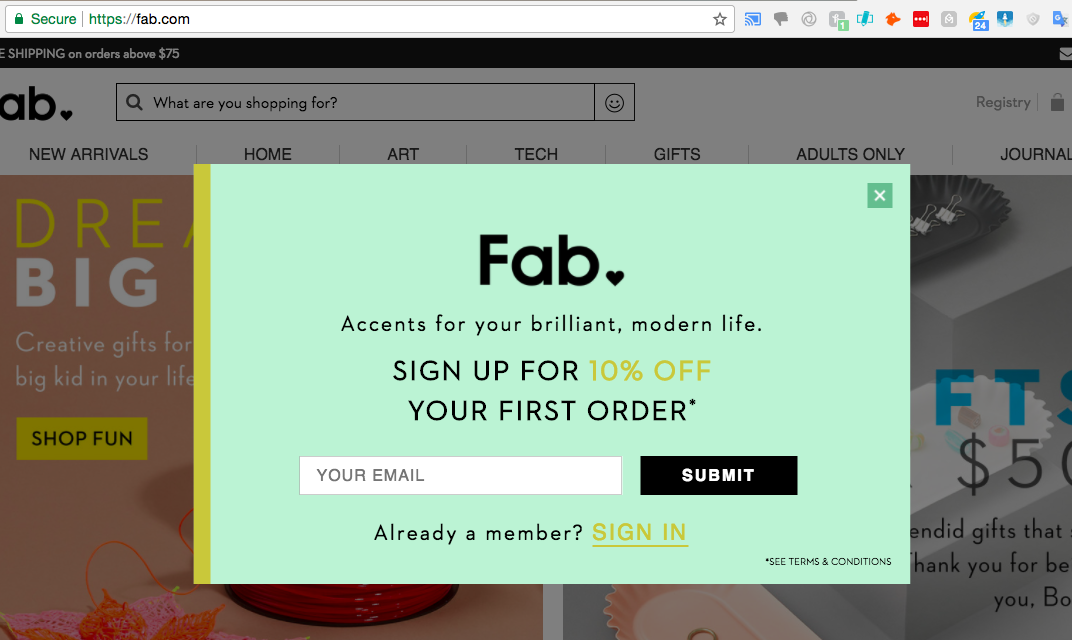
These guys are on the first page for the keyword “Digital cameras”. Everyone on that page a freaking SHARK in the SEO world. BrandsMart USA not only holding their ground but making tremendous sales:
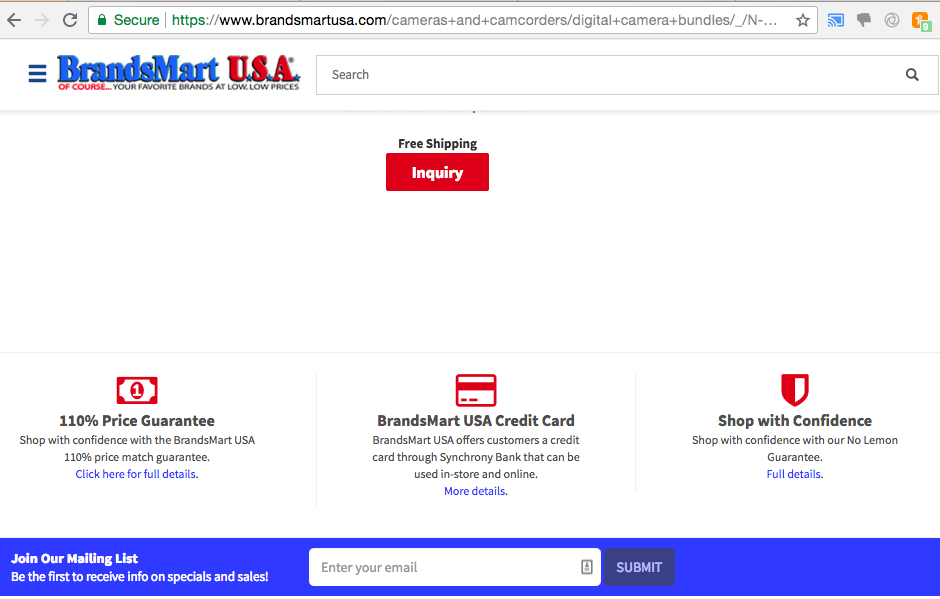
So as you can see, there are many different offers that you can present your visitor with.
Just offer them something helpful and most likely, they will sign up for sure.
So now that you have some idea on how to setup an offer, let’s look at how to setup a winning email sequence.
The Email Sequence
Now that you have your ‘LEAD’, how do you convert it to a buyer?
Before you setup your email sequence, I want you to understand how to convert a ‘lead’ to a buyer.
This where the ‘Conversion Cycle’ comes in.
Of course it’s just an example but hopefully this will help you understand the “psychology” of a buyer.
‘Conversion’ basically refers to when your lead takes action (Purchases something from your website).
Or
When a visitor does something that you wanted them to do in the first place.
Basically, take the desired action.
| Stages of a Conversion Cycle | Visitor’s Action Stage | Visitor’s Mind Set | Conversion Cycle |
|---|---|---|---|
| Stage 1: | After seeing a lot of wonderful information on your site, and your opt-in offer “Sign up and get 50{ebd8a23e45966e4b59db7b7dd2908250df474fbe8f417fdeff24df65f4edfd87} off on your initial purchase!” the visitor signs up using your opt-in form. | “Wow, 50{ebd8a23e45966e4b59db7b7dd2908250df474fbe8f417fdeff24df65f4edfd87} off sure sign me up! | The beginning of the conversion cycle . . . |
| Stage 2: | After 7 days, you send them a friendly newsletter with new product info etc. | “Oh, nice, hmmm cool stuff and if I buy I’ll get 50{ebd8a23e45966e4b59db7b7dd2908250df474fbe8f417fdeff24df65f4edfd87} off as well. Okay. Let me have a look but I don’t know if I’m ready to buy just yet”. | The buyer wants their 50{ebd8a23e45966e4b59db7b7dd2908250df474fbe8f417fdeff24df65f4edfd87} discount and the product but is still unsure . . . Good news is now the trust level is getting higher. |
| Stage 3: | After 14 days, you send them another newsletter with new product info etc. | “Oh sweet look at these products, I might be interested in getting it at this point . . .hmmmm” | Trust level is much higher than last week. Initial doubt of being a fake website or a fly by night operation is disappearing. Now, they are getting more interested in doing business with you for sure. |
| Stage 4: | After 21 days, you send them another newsletter with new product info etc. | “Do they still have that product on sale? Oh they don’t? Hmmm I wish they did I would have probably got it this time”. | Doubts of being a fake website are gone, they are now awaiting any good deals so they can make a purchase if necessary. |
| Stage 5: | After 28 days, you send them another newsletter with new product info etc. | “Oh I remember these guys, I can sure go for that product. Wow, it’s back, I want it and I’ll get it at 50{ebd8a23e45966e4b59db7b7dd2908250df474fbe8f417fdeff24df65f4edfd87} off! Yes!”. | The buyer knows you are for real, likes the discount and buys their first product. You delivered their product on time, promptly and in a professional manner. Congratulations. Now you got a customer for life. |
You see how ?
Most marketers say that you have to contact a visitor 7 times before they take action. I guess it varies but on average, that’s what a lot of experts say.
It depends on various things like your initial offer, the first impression of your website and so on but overall, most people would say that yes 7 definitely the number.
If you really think about it, this whole process it’s nothing but human nature.
For example, do you remember the first time you met someone at your and started somewhat of a friendship with them?
How long did it take for you guys to hangout after ?
How long did it take for you guys to go to the local bars together and develop a friendship or something along those lines?
A certain period of time must pass before we start trusting each other.
It’s normal, it’s human nature and the same thing goes here.
It takes a little time before you convert a total stranger to your customer.
So to create this ‘conversion’, you need to send emails to your lead on a regular basis.
How to set up your Email Sequence?
This where you need to be a little strategic and plan your sequence out on paper before setting it up.
I’m going to use this site as an example.
When someone signs up through my homepage or blog, they get hit by the following weekly email sequence.
As you can see, each week they get redirected to a case study. Another look at it they get redirected to a page. This keeps sending traffic to all my pages on a regular basis which keeps my site in front of anyone who’s interested AND helps me keep rising in the search engines due to on going consistent traffic.
Here a diagram that will help you understand more:
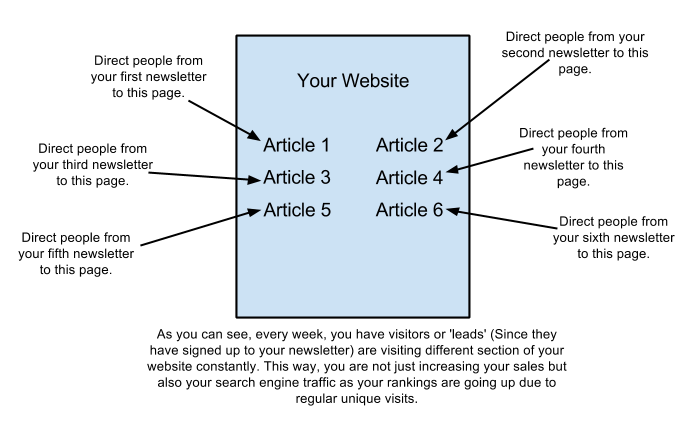
This one of the most powerful way of getting real people to your website and at the same time, it keeps your website rising in the search engines because you are getting real people to your website (From unique IP addresses) on a consistent basis.
Powerful ain’t it?
Increasing sales and increasing conversions automatically.
This how you stay on the of Google and dominate your niche while making sales.
I love it.
In addition, at the bottom of each email they get, there a line that reads:
PS: I hope you enjoyed this case study. If you would like to see similar results for your business, contact me here:
That’s it.
My simple call to action.
So moving forward, spend some time on creating a good email sequence and definitely try to be as strategic as possible. Take a few days for it and plan it properly.
This way, you’ll get the most bang for your buck.
So now that you understand how this system works, I would like to share my own “Advanced Strategies”.
What Should I Put In My Emails?

The content within your newsletter should be relevant to the you are catering to.
Basically, sending them the content that you promised them once they signed up. I mean that’s pretty obvious.
Here An Example of Amazon’s Newsletter:
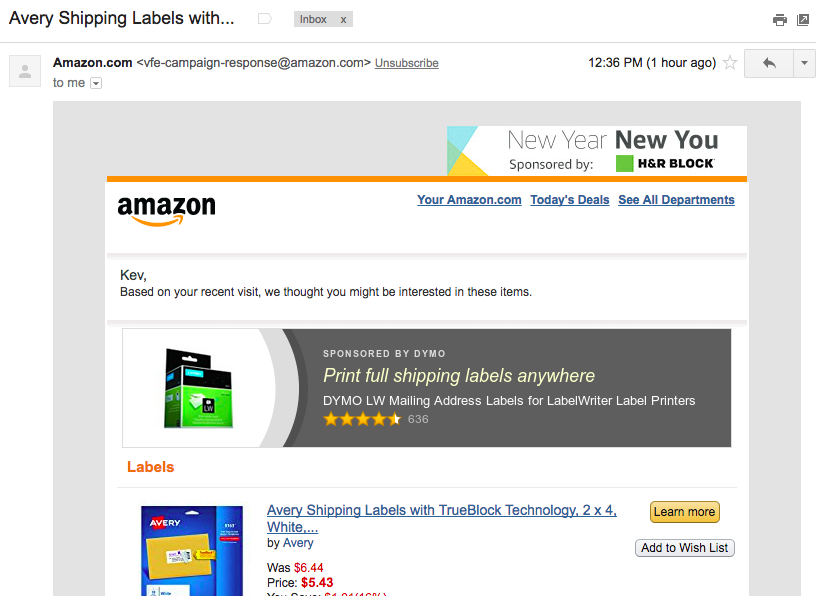
You see, Amazon uses this system too.
After all, you don’t become an e-commerce boss by not utilizing every tactic in the book and then some.
So what should you put in your newsletter?
The type of content you should put in your emails really depends on what your wants and your creativity.
However, one thing to remember always direct them to content that on your site.
Or it would kind of defeat the purpose.
Here are some ideas that will help you create some content for your emails:
- Create 99 or 50 or 10 or lists of that nature (These are very popular). For example: 99 reasons why you should not watch a scary movie,etc – Depends on your niche of course.
- Make Videos / Tutorials and place them on your site somewhere. These days, literally everyone goes on Youtube and having videos on your site can help you in your rankings as well.
- Direct visitors to testimonials.
- Direct visitors to case-studies (This can really help increase your conversion rates).
- User personal stories. Nothing beats the ‘human’ connection.
- Feature some industry related news.
- And the list goes on . . .
How Often Should You Send Your Newsletter?

It all depends on your business but once a week pretty common.
Some send an email every two weeks followed by a big newsletter at the end of the month.
If you are an e-commerce site (Selling products / services), do the following:
- Send a weekly newsletter with just an article and a ‘soft sale’ note at the bottom of the email.
- Then at the end of the month, send a newsletter with discounts and sale information. Kind of a re-cap of the information you sent earlier that month.
So total 5 newsletters per week.
This works fairly well if you are selling a few products or what not.
What a “Soft” Selling?
It’s when you try to sell something without forcing someone or being to direct about it.
A good example sharing a comparison table with your visitors (They convert a lot by the way as well).
Example: Check out how our compares to the competition.
That’s all you need to say in your email followed by the link to the comparison chart. Done.
Should I Use HTML Or Send Plain Text Emails?

Send both. Your job to make sure that as many people on your email list get your newsletter so send both. If you don’t have a choice to send you emails in both formats, than use plain text. Plain text emails have a much higher deliverability rate anyways.
A simply email like this works best. You can use the following template as well.
[START OF TEMPLATE]Hey [First name],
Your weekly newsletter ready!
Click the link below to access it.
http://www.mysite.com/linktoanarticleonmywebsite
Sincerely,
Name of your business . . .
PS: [ENTER YOUR MESSAG] [END OF TEMPLATE]
On What Day Should You Send Your Emails?

Depends on your business but generally speaking, Sundays are good as people are and relaxed.
Tuesday / Wednesdays are also good days as it’s the middle of the week and people have already “settled” with their day jobs.
Some people would say Sunday’s are bad because people are usually out but it all depends on your target .
My rule of thumb if your target mostly people under 35, get them during the middle of the week.
If older, than go for early Sundays.
It all depends on your target and your business.
What Time Should You Send Your Newsletter?

First thing early in the morning (8am to 9am on weekdays) or around noon to 3pm if it’s a Sunday.
On weekdays, most of us are use to doing things early anyways and this includes checking email.
So this a good time to get your message in front of people’s eyes.
Again, test what works for you and your business but this how I do it.
Should I Do Any Manual Email Sending?
Well this system designed to be fully automated but you can send manual emails in the shape of a monthly newsletter.
This again, depends on who your target and why they come to your site.
However, you should be using both methods.
100 percent automated emails that fire by themselves once a week are great to build a relationship but to get a sizeable increase in sales every month, send them a newsletter once a month that all about discounts or just sales in general.
Test what works and you’ll have an an answer soon.
Using A PS or Postscript In Your Emails
Here an example of when I was taking care of a super club in Dubai called Chi at the Lodge,
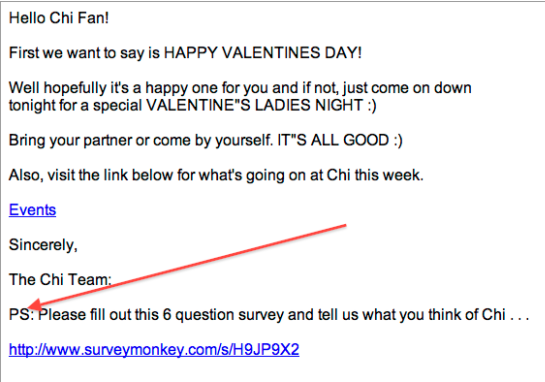
When you use a PS, it’s basically another opportunity for the visitor to take action. However, when you add anything after the PS, it somehow (Psychological effect) makes whatever you talked about in that sentence somewhat important.
You don’t have to use a “PS” in all your emails but definitely use them periodically to increase further action.
Now that you understand the process and how to setup your email sequence, etc.
Let’s look at some additional and advanced strategies that will help you right off the bat.
Strategic Spots To Place Your Opt In Form
Have you ever seen a website with something similar to any of these images?
Focus on what the yellow arrow pointing at:
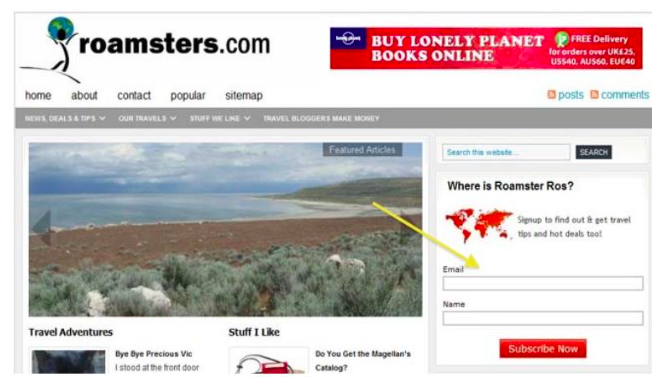
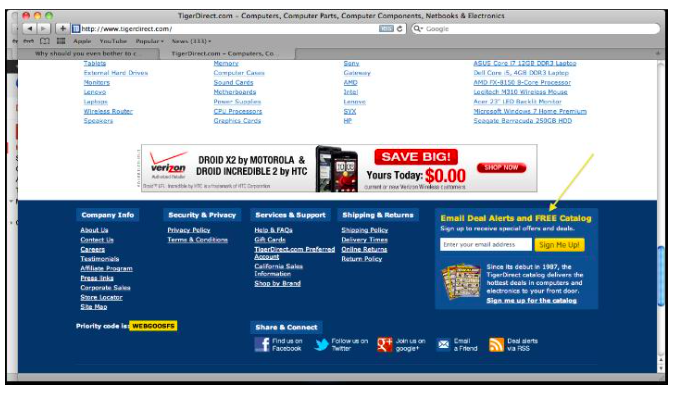
The place where you see the yellow arrow pointing to called an ‘opt in’ form. It’s job to collect email addresses from anyone who interested in giving it.
Also known as an email capture form.
The whole idea to offer something of value to this specific visitor such as an eBook, a free report, discounts etc that will help create a relationship with them. Basically what I shared earlier.
This equivalent to a ‘brochure’ that you might give to someone if they walk into your physical store and in return, you get their contact information.
At this point, the ‘Visitor Type 2’, who responsible for 90 percent of your business, becomes a ‘Lead’.
Where Should You Place Your Opt-In Offers?

Rule of thumb on each visit, you should give your visitor 3 minimum opportunities to sign up.
Remember, this group of people (Visitor Type 2) are 90 percent of your business so it’s only in your best interest to get them to take action.
Let’s discuss the 5 best places to put your opt-in offers.
- Hover ad that slides from the .
- An opt-in form in your sidebar.
- Opt-in form at the end of the your article.
- Peel Ads.
- Footer Ad.
Hover Ad That Slides From The
A hover an opt-in form that floats from the , sides, bottom (Anywhere you like) of the website as soon as a visitor enters it.
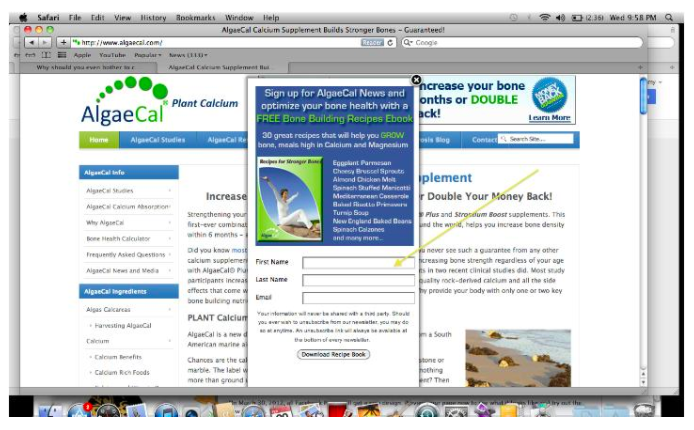
No this not those pop up ads that disappeared as soon as they came across few years ago (And got blocked by popular browsers such as Internet Explorer, Firefox and everyone else).
These are ads that only ‘drop’ in when a visitor comes to your site for the very first time. Of course you can set that part up too but that’s how it works.
Any internet marketer will tell you that yes they Especially if your offer worth it. Anyone calling this annoying someone who hasn’t tried them yet.
I’m really that confident about them and have used them for years and will continue to do so. It’s all about how you you use them.
An Opt-In Form In Your Sidebar
This the tried and tested way of getting leads. The best place be right at the or at the second level. You can test different places out but the higher the better.
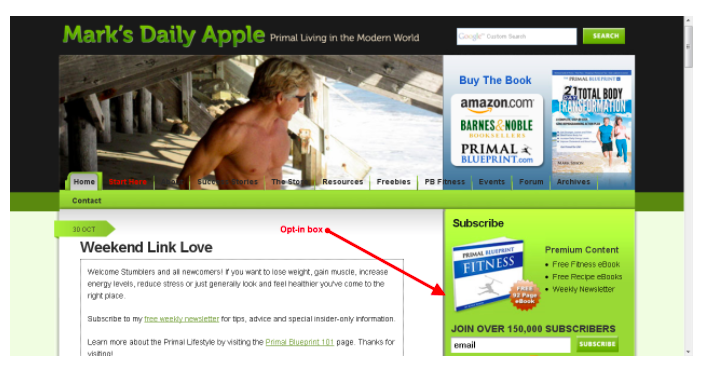
Opt-In Form At The End Of The Your Article.
When a person reads your article and likes it, it’s your job to guide them further. Why not guide them to sign up to your newsletter?
“Hey if you like this article? sign up below and every week you’ll get tons of awesome information!”
See what I’m saying . . .
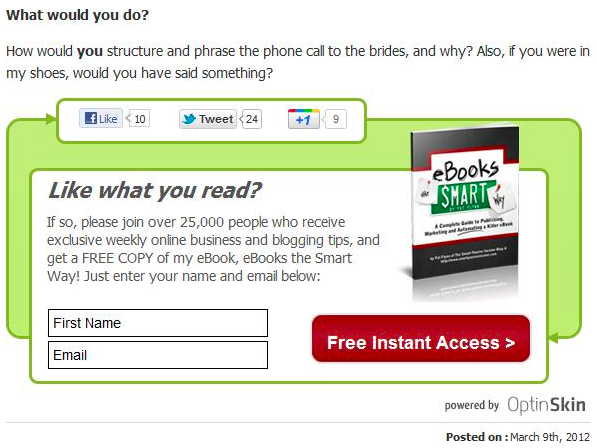
When posted at the end of an article, this works very well. Especially if the user likes your article. At this point, when the visitor feeling ‘pumped up’ about the information you just shared and excited about it, this the best time to direct your customer to your newsletter offer. Put an opt-in form at the end of an article with a nice ‘Call to action’ and it will definitely increase your customer database (Leads).
Peel Ads
This what a peel ad looks like. It’s basically flash and I’m not going to lie, it actually looks pretty good.
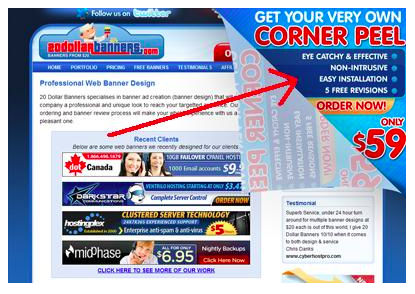
Low on performance but still pretty good. I think it all matters on your offer and your website but overall, it performs to a certain degree but not as good as a sidebar or a hover ad.
Definitely raises the ‘perceived value’ of your site though which always a good thing.
Just thought I’d share it with you.
Footer Ad
I’m a fan of footer ads and if you use them right, they can really produce good results. Don’t make them too annoying or they won’t . Use them once indefinitely and they great.
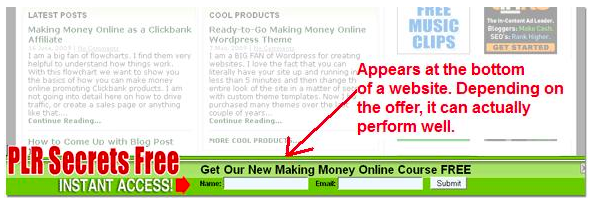
However, my tests have shown that they do if you have a nice offer.
The idea to test different offers and see what works for you and your target . The Hover Ad, The sidebar and the footer links are just the methods to help you convert more of your traffic.
How To Setup Your Opt-In Offer?
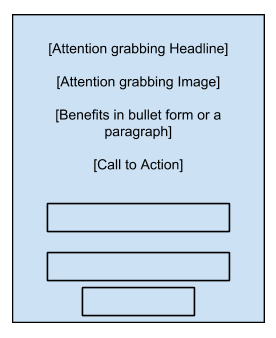
I want to make a point here before you move further.
A lot of people confuse ‘Features’ with ‘Benefits’.
If you want your visitor to take any kind of action, always focus on the benefits.
Nobody cares how ‘’ your . That a feature.
A benefit would be “No more waiting for hours” or something similar to that . . .
Remember, focus on benefits, not the features.
Add a link (Not an ‘opt-in’ form) at the bottom of your article.
If you are not interested in putting an opt-in form, try putting a link at the bottom of your post or article that reads something like:
“If you like this article, click here and join my newsletter”.
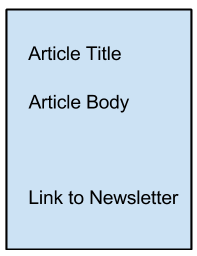
Than direct this link to a squeeze page aka landing page. I discuss this method next.
Landing Pages Convert Higher
A squeeze page or a landing page a page that contains nothing more than your opt-in form or other very few elements.
The idea to get the visitor to just focus on the opt-in form so we can literally “squeeze” their contact information out of them.
So if you replace opt-in email forms with just images leading to a landing page, your conversions just might be a lot higher.
Example of a squeeze page:
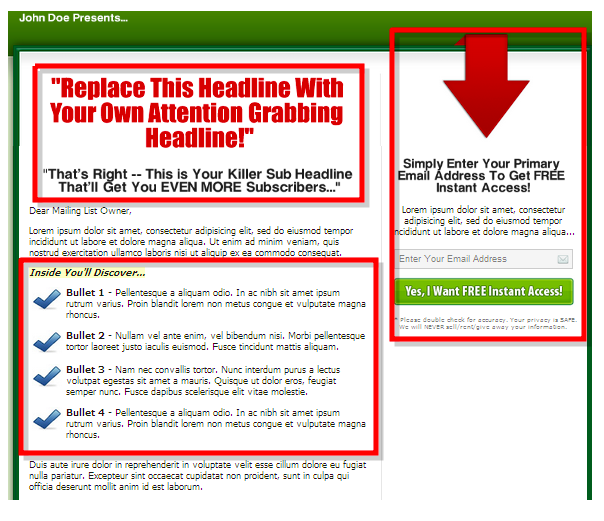
Here how the “Links re-directed to a squeeze page” would look like:
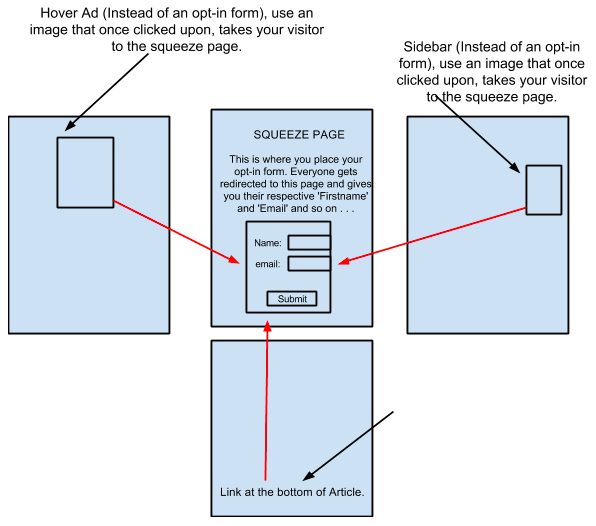
In my opinion, if you can really drive traffic to a landing page, the conversions are much higher. Minimum 20 percent conversion rate in my experience. Yes it’s that’s high.
That said, using an email form where necessary a method and always performs at a steady respectable rate.
Test what works for you.
List Segmentation
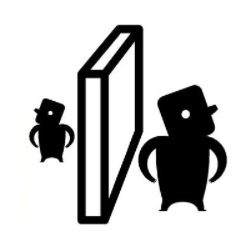
90 percent of people don’t do this and even I myself was a little too late to this party (As the company that I was working for demanded this).
List segmentation basically means dividing your list up into more smaller more targeted lists.
By the way, the word “List” refers to your customer database that you built using your opt-in forms.
Basically people who signed up (Visitor Type 2).
Let me give you a personal example:
Few years ago, I was working at a nightclub in Dubai as their Events Manager and SEO / Social Media consultant. We started our Autoresponder / Newsletter system and finally started building a customer database that we can to on a weekly basis.
However, soon some customers started complaining and started replying to our newsletters with “I don’t care about R&B music acts, I just like House! Stop inviting me on R&B nights please!” and vice versa.
This meant that It was naturally time to segment or divide our list (Customer database).
I quickly added another option on all our opt-in forms on our website:
“Please select your music type” and gave them two options “House” & “R&B”.
Soon our list became segmented properly and we started getting more revenue without pissing people off.
We gave the people what they wanted and we kept winning.
You can segment your list in a lot of ways but another popular way to segment your list by customers who buy more products and by customers who don’t spend that much.
You see, you can segment your list in a lot of ways. Depends on what your business demands and what works.
Ask For The First Name
[First Name]
When it comes to sales, it all comes down to building relationships.
It’s very hard to build a relationship with someone when you don’t even know their name so getting your visitor’s first name essential.
There a also a psychological reason behind getting your visitor’s name and that when you ask for a visitor’s name, it raises the perceived value of your site.
Unless you are already an authority in your niche, people will have a hard time just giving out their email address.
Asking for the first name makes the visitor more comfortable to give their contact information when compared to someone just asking for an email address.
So always give the visitor an opportunity to enter their first name in your opt-in form.
Attention Grabbing Email Titles To Increase Open-Rates.
You can have the best information but if your emails are not even being opened, than you are pretty much done for.
That’s what ‘Open-Rate’ refers to.
Keep your email subject lines short, keep them personalized (Always use a person’s first name) and keep them to the point.
Hype not necessary, keep it real.
For example:
- [Firstname], get 75 percent off cookware and metal utensils.
- [Firstname], your Weekly Newsletter ready.
